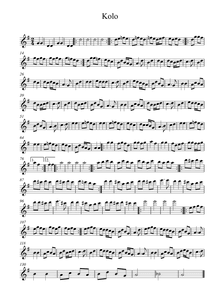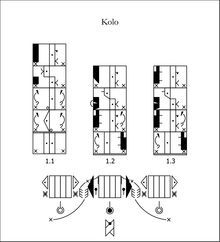KOLO
It is also known as Veliko kolo, or Kolo na jednu stranu, but the Sokac call it Kupusarsko kolo. It is always the first and closing piece at a dance. The words Ajd’ zaigrajmo! invite people to dance Kolo. It is danced both by men and women in a closed circle. In the old times, the order of one man one woman was strictly followed, women putting their hands on the shoulder of men (holding a woven handkerchief, maramica, in their right hand, which they sometimes waved during the dance while yelling), the men, standing in front of or behind the women, holding each other’s hands, or sliding their hands into the cloth, serving as a belt, on the women’s waist. Lately, several men (shoulder hold) or women (holding hands or crossing them behind the back) may stand beside each other, everyone with slightly raised hands or arm-in-arm.
Kolo always starts to the left and slowly moves left. For bagpipe music, the bagpiper occasionally used a short improvisational part (tiny bounces while the piper filled his bag with air and tried some tunes). The tamburica band begins with eight direct beats (signaling the tempo of the dance), then the dance started with simple stepping motifs. Women can enrich their dance with a motif well-known all over Baranya and Bačka. Men do a more difficult variation of this motif, but also perform lots of heel klicks, stamping and cross steps in the free part of Kolo, which starts after a change in the musical tune (new tune). After this, the stepping motif may return for the sake of rest, then the improvisation again, but with increasing speed. This is signposted by a yell for the piper from Kökény:
Oj gajdašu, živina ti prste, Hey, piper, damn your fingers
Zar ne vidiš, kako noge krste! Can’t you see, our feet are getting tangled!
Marcika, Kloćo, Pöttyös used to be pipers in Kökény.
There is a rule concerning the enrichment of Kolo as well as all Bosnian dances: both feet must not be in the air at the same time. It should be danced with small steps, on the whole sole, with sharp, but not jumping trembles. The men pinned colorful pearls (dronke) onto their hats, the girls wore necklaces made of silver coins (cvancike, križaki), so these gave a rattling sound during the dance. The most important feature of the Bosnian dance is the tremble (drma) paired with a pleasant posture.
The songs in the Kolo most probably developed from the yells, which, initially, could be started at any time but later were placed on a specific tune part (e.g., Alaj volim u kolu igrati). The improvised songs and yells were of considerable importance in the life of the village. Pieces of news, village events, gossip were made public in this way, so there were always lots of bystanders around, who were interested not only in the show but mostly in the transmitted information. The lyrics narrated about married life, love, lovers, the parish priest, officeholders, musicians, or dancers, often in a joking or criticizing manner.
Each band has its own Kolo music, which consists of similar tunes or the same tunes linked together in a varied way. This characterizes the whole of the southern areas, called Southern Region (territories named as D musical dialect by Vujicsics Tihamér). The most frequently used tonalities are E and A, as these are the basic sounds of the bagpipe and the tamburica band.
This was the oldest and most popular dance with some famous dancers such as Udvarácz Márkó from Áta, who threw his hat into the air while dancing, and it miraculously landed right on his head after one or two beats. Wearing the hat on one side a bit signaled a party man, who loved dancing, bećar, (also the favorite of women).
MUSIC




